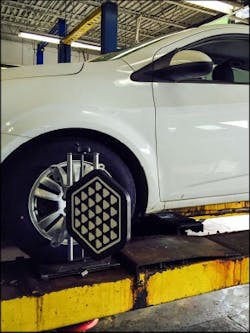The choice to purchase an alignment rack depends on a few things, including the shop’s particular business model and size, says Marty Long, owner of Hills and Dales Auto Care in Canton, Ohio. Smaller shops may find it difficult to justify an alignment rack. Shops that perform a lot of steering, suspension and tire work, however, could greatly benefit from alignment equipment.
Although Long’s business began as a small facility, he soon found performing alignments was a perfect complement to his business. Since then, it’s become a valuable profit center for the shop. Long explains how to make alignments worth the investment.
When we started the business, we had no alignment rack and we had to sub out all of our alignments, which was a pain having to wait on other people. We were running into that so frequently that we decided it was time to purchase a fourpost rack and alignment machine, so we could keep everything in house. Although the equipment is expensive, we knew that if we marketed and handled the service correctly, it would yield a relatively quick ROI, rather than continuing to sublet out the work.
Now we do at least three or four alignments every day. They’re a huge profit center and add-on sale for the shop when done quickly, accurately and right the first time. It’s not just the alignments that will make you money, but also the other steering and suspension work on top of that.
The first key is taking care of your alignment machine. We recently invested in a Hunter machine. It’s two years old and we purchased it for roughly $17,000, not including the lift we also needed. It’s quick, it’s easy, and it’s accurate. But having the newest or best machine isn’t absolutely necessary. What is necessary is making sure the rack is regularly maintained and updated so you’re producing the best quality product you can from your machine. If it’s just slow and cumbersome, that’s not helping you make money off the work.
Next, you have to actually use the machine. That sounds obvious, but many shops end up letting it collect dust. Make it part of your inspection process, when you can. Being eight bays here, we do a lot of inspections. The roads are pretty bad in our neighborhoods after the winter, especially, so we do a lot of tie rods, ball joints, struts, tires, and a variety of front-end work. If we’re doing an oil change and we see tire wear, we’ll suggest the alignment.
It’s all about selling the benefits to the customer. Any time we sell tires, we’ll do an alignment because we tell the customer, “We both have to live with your purchase of the tires. An alignment will enhance the steering performance and extend the lift of the tires, which will save you money in the long run.”
One tool that is absolutely golden is the colored print-out that comes with most systems now. It gives you a before and after picture of the vehicle that’s very easy for customers to read. You can present that to the customer and say, “Here’s where it was before, and here’s where we are after. We’re confident that when the car leaves, we’re not going to have any problem with tire wear.” It almost sells itself after that.
If a customer asks for an alignment, you need to ask why. Many times they are referring to something else. For example, a customer may ask for an alignment check but after asking why, they might say, “The steering wheel shakes at a high speed.” You always need to be a good detective. It’s a lot of asking questions about why they want an alignment to find out whether it’s truly an alignment issue or a wearing and pulling issue, or more of a vibration when they’re going down the road. Also, always road-test the car prior to any alignment and perform a steering/ suspension check.
As far as charging a fee, that depends on the vehicle. Our standard two-wheel alignment is $89.95 and four-wheel alignment is $109.95. That’s as long as it has the mechanical cams that you turn to do the alignment. If there’s a cam or brushing that’s frozen or if it’s a different type, we do charge an additional fee for doing those.
When it comes to charging for alignments, you don’t want to be the lowest guy in town. Again, that’s really why you need to sell the value. All my techs are ASE certified, most of them are long-term employees and they are well compensated. When you have a master tech doing a wheel alignment, you know it’s going to be right and done in a timely fashion. You can create a package, also, that encompasses alignments, tire rotation and balance, and a suspension/steering check.
The beauty of alignments is that, when priced correctly, they are high-margin items. For the alignment itself, other than what you pay your technician, the rest is nearly profit. And the suspension work that you get on top of that—whether it’s doing tire rods of ball joints—those are all high margin tickets.



